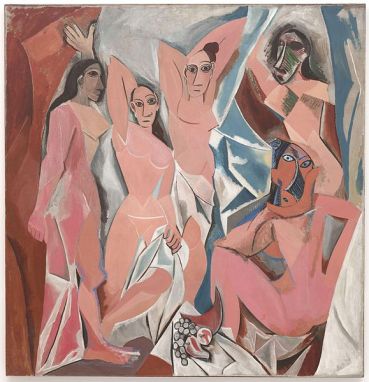Cubism began between 1907 and 1911. Pablo Picasso’s 1907 painting Les Demoiselles d’Avignon has often been considered a proto-Cubist work. Georges Braque’s 1908 Houses at L’Estaque (and related works) prompted the critic Louis Vauxcelles to refer to bizarreries cubiques (cubic oddities). Gertrude Stein referred to landscapes made by Picasso in 1909, such as Reservoir at Horta de Ebro, as the first Cubist paintings. The first organized group exhibition by Cubists took place at the Salon des Indépendants in Paris during the spring of 1911 in a room called ‘Salle 41’; it included works by Jean Metzinger, Albert Gleizes, Fernand Léger, Robert Delaunay and Henri Le Fauconnier, yet no works by Picasso and Braque were exhibited.
By 1911 Picasso was recognized as the inventor of Cubism, while Braque’s importance and precedence was argued later, with respect to his treatment of space, volume and mass in the L’Estaque landscapes. But “this view of Cubism is associated with a distinctly restrictive definition of which artists are properly to be called Cubists,” wrote the art historian Christopher Green: “Marginalizing the contribution of the artists who exhibited at the Salon des Indépendants in 1911 ”
Historians have divided the history of Cubism into phases. In one scheme, the first phase of Cubism, known as Analytic Cubism, a phrase coined by Juan Gris a posteriori, was both radical and influential as a short but highly significant art movement between 1910 and 1912 in France. A second phase, Synthetic Cubism, remained vital until around 1919, when the Surrealist movement gained popularity. English art historian Douglas Cooper proposed another scheme, describing three phases of Cubism in his book, The Cubist Epoch. According to Cooper there was “Early Cubism”, (from 1906 to 1908) when the movement was initially developed in the studios of Picasso and Braque; the second phase being called “High Cubism”, (from 1909 to 1914) during which time Juan Gris emerged as an important exponent (after 1911); and finally Cooper referred to “Late Cubism” (from 1914 to 1921) as the last phase of Cubism as a radical avant-garde movement. Douglas Cooper’s restrictive use of these terms to distinguish the work of Braque, Picasso, Gris (from 1911) and Léger (to a lesser extent) implied an intentional value judgement.
The assertion that the Cubist depiction of space, mass, time, and volume supports (rather than contradicts) the flatness of the canvas was made by Daniel-Henry Kahnweiler as early as 1920, but it was subject to criticism in the 1950s and 1960s, especially by Clement Greenberg. Contemporary views of Cubism are complex, formed to some extent in response to the “Salle 41” Cubists, whose methods were too distinct from those of Picasso and Braque to be considered merely secondary to them. Alternative interpretations of Cubism have therefore developed. Wider views of Cubism include artists who were later associated with the “Salle 41” artists, e.g., Francis Picabia; the brothers Jacques Villon, Raymond Duchamp-Villon and Marcel Duchamp, who beginning in late 1911 formed the core of the Section d’Or (or the Puteaux Group); the sculptors Alexander Archipenko, Joseph Csaky and Ossip Zadkine as well as Jacques Lipchitz and Henri Laurens; and painters such as Louis Marcoussis, Roger de La Fresnaye, František Kupka, Diego Rivera, Léopold Survage, Auguste Herbin, André Lhote, Gino Severini (after 1916), María Blanchard (after 1916) and Georges Valmier (after 1918). More fundamentally, Christopher Green argues that Douglas Cooper’s terms were “later undermined by interpretations of the work of Picasso, Braque, Gris and Léger that stress iconographic and ideological questions rather than methods of representation.”
John Berger identifies the essence of Cubism with the mechanical diagram. “The metaphorical model of Cubism is the diagram: The diagram being a visible symbolic representation of invisible processes, forces, structures. A diagram need not eschew certain aspects of appearance but these too will be treated as signs not as imitations or recreations.
“

